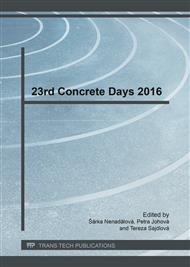p.215
p.221
p.227
p.232
p.238
p.244
p.249
p.255
p.263
Thin Lightweight Panels Made of Textile Reinforced Concrete
Abstract:
Use of high performance concrete with reinforcement made of technical textile is increasing and new applications are being found. This paper presents new technology for the lightening of the panels made of textile reinforced concrete, which is being developed. The main focus of this research is to produce concrete elements suitable for use as facade panels with the least possible weight and environmental impact. Mechanical characteristics were measured on testing specimens with thickness of 18 mm with lightening representing 47% of their volume. Minimum thickness of concrete was 4 mm and therefore the reinforcement was covered by approximately 1.5 mm of concrete matrix. The strength of experimental test panels was measured in four-point bending stress test. Due to one-sided lightening and asymmetrical cross-section therefore, the tests were performed in both directions. For better interpretation of the results were the specimens of lightened panels tested alongside non-lightened specimens with the same thickness. Based on measured values, maximal dimensions of lightened facade panels were designed.
Info:
Periodical:
Pages:
238-243
Citation:
Online since:
May 2017
Authors:
Price:
Сopyright:
© 2017 Trans Tech Publications Ltd. All Rights Reserved
Share:
Citation:


